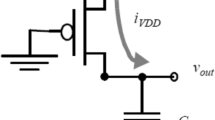Abstract
This paper presents a Built-In Self-Test (BIST) technique to test the setup and hold times of memory interface circuitry. The BIST scheme generates data and clock using an on-chip pattern generator. The relative timing difference between data and clock is controlled using a cycle-by-cycle control method for testing. Two test methods of static and dynamic modes have been presented to measure the timing difference and then are used to specify the setup and hold times. The static mode is mainly used to detect pass or fail for timing specifications, and the dynamic mode is devised to measure the amount of timing mismatches and thus detect timing margin degradations due to the timing delay mismatches. Using these two test modes, the BIST scheme obtains test results with low frequency signals, which are compatible with low performance testers. The test chip including the BIST scheme has been fabricated with a commercial 0.18-μm CMOS process. The chip measurement results are shown to validate the testability of the BIST scheme for the setup and hold times of memory devices.















Similar content being viewed by others
References
Baker RJ, Li HW, Boyce DE (1998) CMOS circuit design, layout and simulation. Wiley, New York
Dally WJ, Poulton JW (1998) Digital systems engineering. Cambridge University Press, Cambridge
DDR2 SDRAM specification (2006). In: JEDEC JESD79-2C. JEDEC Solid State Technology Association
Huang CC, Oh KS, Rajan S (2001) The interconnect design and analysis of RAMBUS memory channel. In: Proceedings of ASME IPACK2001, IPACK2001-15531
Jia C, Milor L (2009) A DLL design for testing I/O setup and hold times. IEEE Trans Very Large Scale Integr (VLSI) Syst 17(11):1579–1592
Keezer DC, Minier D, Ducharme P (2006) Source-synchronous testing of multilane PCI express and hypertransport buses. IEEE Des Test Comput 23(1):46–57
Kim H, Chung J, Abraham J, Byun E, Woo C-J (2010) A built-in self-test scheme for high speed I/O using cycle-by-cycle edge control. In: Proc. European test sympo., pp 145–150
Laquai B, Braun M, Walther S, Schulze G (2007) Flexible and scalable methodology for testing high-speed source synchronous interfaces on automated test equipment (ATE) with multiple fixed phase capture and compare. IET Comput Digit Tec 1(3):154–158
Mahapatra NR, Venkatrao B (1999) The processor-memory bottleneck: problems and solutions. In: ACM crossroad, http://www.acm.org/crossroads/xrds5-3/pmgap.html
Mak TM, Tripp M, Meixner A (2004) Testing Gbps interfaces without a gigahertz tester. IEEE Des Test Comput 21(4):278–286
MM et al (1994) A 200MHz 13 mm 2-D DCT macrocell using senseamplifying pipeline flip-flop scheme. IEEE J Solid-State Circuits 29:1482–1490
Muljono H, Lee B-T, Tian Y, Wang Y, Atha M, Huang T, Adachi M, Rusu S (2003) A 400-MT/s 6.4-GB/s multiprocessor bus interface. IEEE J Solid-State Circuits 38(11):1846–1856
Provost B, Huang T, Lim CH, Tian K, Bashir M, Atha M, Muhtaroglu A, Zhao C, Muljono H (2004) AC IO loopback design for high speed uProcessor IO test. In: Proc. int. test conf., pp 23–30
Sivaram AT, Shimanouchi M, Maassen H, Jackson R (2004) Tester architecture for the source synchronous bus. In: Proc. int. test conf., pp 738–747
Sunter SK, Nadeau-Dostie B (2002) Complete, contactless I/O testing—reaching the boundary in minimizing digital IC testing cost. In: Proc. int. test conf., pp 446–455
Treur R, Agarwal VK (1993) Built-in self-diagnosis for repairable embedded RAMs. IEEE Des Test Comput 10(2):24–33
Tripp M, Mak TM, Meixner A (2003) Elimination of traditional functional testing of interface timings at Intel. In: Proc. int. test conf., pp 1014–1022
Author information
Authors and Affiliations
Corresponding author
Additional information
Responsible Editor: D. Keezer
This manuscript is an extended version of a paper presented at the 15th IEEE European Test Symposium, May 2010.
Rights and permissions
About this article
Cite this article
Kim, H.J., Abraham, J.A. A Built-in Self-Test Scheme for Memory Interfaces Timing Test and Measurement. J Electron Test 28, 585–597 (2012). https://doi.org/10.1007/s10836-012-5324-1
Received:
Accepted:
Published:
Issue Date:
DOI: https://doi.org/10.1007/s10836-012-5324-1




